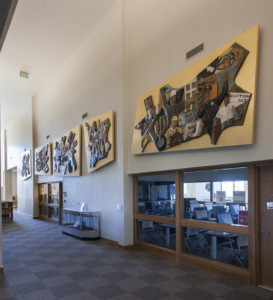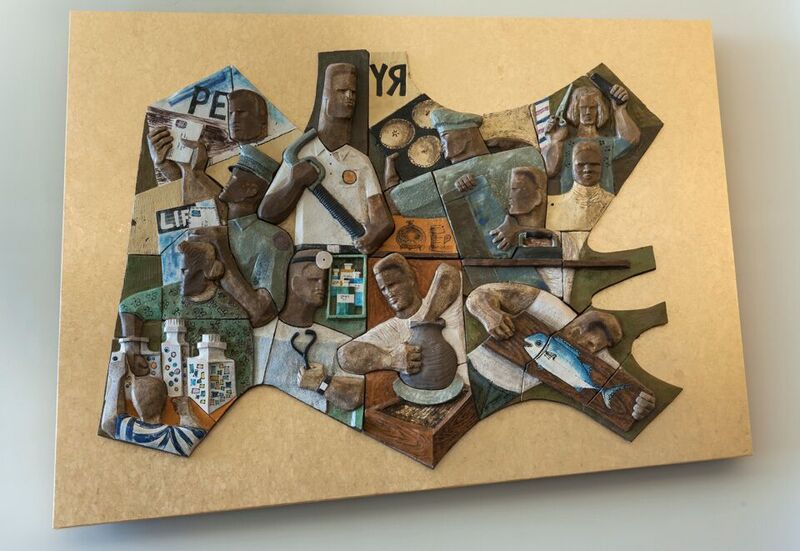Preservation of the Isami Enomoto Labor Murals
May 9, 2018
John B. Williams
The preservation, and relocation, of the Isami Enomoto Labor Murals was a collaborative effort on the part of a large bank, an organization dedicated to the history of labor unions in Hawaii, an all-volunteer non-profit, large and small money donations from organizations and individuals, and many hours of donated time. It is a wonderful example of a community coming together to preserve a piece of Hawaiian history.
The story begins in 1960 when the Bank of Hawaii was constructing a new branch bank at 727 Kapahulu Avenue in Honolulu. A set of ceramic murals was commissioned that would be installed on the wall above the teller counter, and the goal was that the murals would be a center piece of the bank’s public space. The selected artist was Isami Enomoto, who was born in Hawaii, had his ceramic studio in the Kapahulu neighborhood, and was a recognized artist.
The theme for the murals was recognition of the laborers and workers in various trades, professions, and small businesses. Murals 2 through 5 each had a separate category: ‘Agriculture’, ‘Building and Construction’, ‘Commerce’, and ‘Transportation’. The first mural, ‘Kapahulu at Work’, is special because all of the figures were based on people who actually worked in the Kapahulu neighborhood.

Enomoto Murals at Bank of Hawai‘i. Photo by David Franzen.
A newspaper article about the May 8, 1961 opening of the new bank branch included that the actual creation of the murals was done in less than a month in order to be installed in time. The manager of the new branch, Walter Yen, was quoted saying about Enomoto and his assistants “. . . for the last three weeks they have been working all day and all night seven days a week. I don’t see how they did it.”
Fast forward 54 years, and the Bank of Hawaii was preparing to close the Kapahulu branch and sell the building. In the months before the closing date of October 30, 2015, the bank had reached out to various organizations trying to find a new home for the Enomoto Labor Murals. Everyone agreed that they deserved to be saved but it was not going to be an easy task and no one was prepared to take it on. Lined up end to end the 5 murals are over 45 feet long, average over 6 feet tall, and are extremely heavy because the ceramic art had been attached to very rigid wooden platforms with steel channels.
The story of the murals, in October 2015, came to the attention of Docomomo US-Hawaii, an all-volunteer nonprofit dedicated to Hawaii’s modern architecture and art. The bank had committed to vacating the building by the end of November and was prepared to remove the murals from the wall and to move them to a new location. Docomomo agreed to take possession of the murals and successfully found a small business in a Kaka’ako warehouse that would let them use some of their extra space for temporary storage.
Now the question became where were the murals to be finally installed and how much was that going to cost? About this time Docomomo learned that the story of the murals was very well known to Dr. William Puette, the Director of CLEAR – the Center for Labor Education And Research – at the University of Hawaii West Oahu campus. CLEAR’s mission includes recording and archiving labor history in Hawaii, and Dr. Puette hoped that at least one of the murals could be installed in CLEAR’s space. Docomomo began meeting with Dr. Puette and realized that there might be room for all 5 of the murals at CLEAR.
2016 was all about working out the logistics. A structural engineer contributed a way to attach the murals on the existing walls at CLEAR. The University of Hawaii West Oahu was involved with reviewing the proposed installation. Another donated warehouse space in Kapolei was found when the murals had to be moved out of the Kaka’ako warehouse. But the new installation would require the skill of a general contractor and that would require fund raising.

Enomoto Murals installed at CLEAR. Photo by David Franzen.
2017 was all about raising the estimated $50,000 needed to accomplish the installation. It was a year long project that was made possible by donations from 12 labor unions, the Enomoto Trust through Isami Enomoto’s two children, and 22 donations from individuals that ranged from very large checks to checks under $100. By October 2017 enough had been raised to start discussions with the general contractor, Elite Pacific Construction, Inc.
The last two weeks of December 2017 were identified as the best time for the installation because the campus would be essentially closed. The first of the two weeks was about hanging the murals which involved from 6 to 12 workers at various times, and a lot of equipment. The second week was devoted to preservation. Although the ceramic art itself had come through the long two year journey with no damage, the gold paper that covered the wood platforms around the ceramic art had been damaged and needed to be replaced. Fortunately a very skilled artist was able to expertly install the new paper, and all of the work was completed by December 31, 2017.
About the Artist: Isami Enomoto
Isami Enomoto was born in Hilo on May 17, 1929, the youngest of 5 children. He was always interested in art and was a commercial art major in college until his senior year, when he took an elective class in ceramics from Claude Horan. That was when he decided to change his major. Enomoto took to clay naturally and became one of Claude’s proteges. He continued to graduate school at the University of Hawaii and eventually became a teaching assistant for Horan. Eventually he joined Ceramics Hawaii which was being run by Claude Horan, and subsequently purchased the company when Horan wanted to focus more on teaching. At the time the studio was in Kapahulu, and later moved to the corner of Cooke and Queen Street across from the Kewalo Theater. Enomoto carried out commissions from significant architects, such as Vladimir Ossipoff and Takashi Anbe. He also collaborated on artwork with Jean Charlot, including the very large murals on the face of the UPW building at 1426 North School Street. Enomoto passed away on February 16, 2016.
John Williams moved to Hawaii after a 35-year career in architecture in San Francisco. He is a Board Member of the nonprofit
Docomomo US-Hawaii, which is devoted to mid-century architecture in Hawaii, and a volunteer with Historic Hawaii Foundation.


